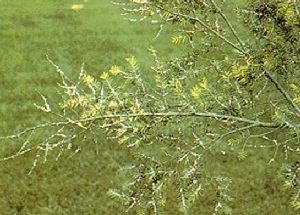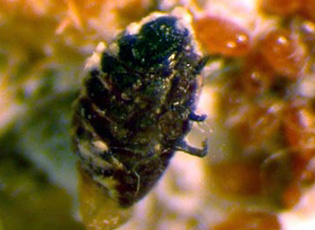A small, aphid-like insect recently found infesting a stand of hemlock trees in south central Ohio has increased fears that it is spreading through the Great Lakes region.

Branch dieback from heavy hemlock woolly adelgid feeding. Photo: Michigan Department of Natural Resources
The hemlock wooly adelgid is usually found in the eastern United States, but now Ohio has been added to Michigan, New York and Pennsylvania as Great Lakes states with the tree-killing insect.
It is the first time the hemlock woolly adelgid has been found in a natural stand of hemlock in Ohio, according to a state news release. It affected eight of the 500 trees in the stand. Previous infestations have been found only on hemlocks used in landscaping and in nurseries.
Ohio officials cut down the trees, burned them and are looking for more insects, said Bethany McCorkle, spokeswoman for the Ohio Department of Natural Resources.
“It could overtake the trees if it spreads rapidly and is an important issue to be aware of and why we are moving quickly to eradicate the trees that are affected,” McCorkle said.
Almost all of the Great Lakes states are home to hemlock trees, but few people are aware of the deadly native-Asian pest that call the hemlock tree home.
It feeds on the sap of the tree and can get to the outer ends of the branches of the new growth, making the trees look like they are covered in wool, said Ron Murray, the forest health supervisor for Michigan’s Department of Natural Resources.
The insect is less than 1/16-inch long, and produces a covering of wool-like wax filaments to protect itself and its eggs for protection and to prevent them from drying out, according to a pest report from the United States Department of Agriculture and Forest Service.
Murray is no stranger to these pests, first recorded in Virginia in 1951.

Adult hemlock woolly adelgid with wax removed. Photo: Michael Montgomery, USDA, Forest Service
“If you pull the wool back, you see the tiny insect in there,” Murray said. “It feeds by sucking out the sap of the tree and creating a dead spot. Once there are enough dead spots, the tree is dead.”
The first of the pests found in Michigan were reported in 2006 in Harbor Springs. They were quickly eradicated. Another infestation was reported in southeast Michigan in 2010 and also successfully eradicated.
“It kills trees pretty readily, usually in one season,” Murray said. “It’s ruthless, and it doesn’t take long.”
Though the hemlock woody adelgid is usually found in ornamental hemlocks and nurseries with important plants, the tiny insect is spreading.
For now, there are no preventative measures to take beyond testing regularly for the pest across the region, Murray said.
Residents should check hemlock trees for the insect if moving or purchasing them from other regions that may be infected.
Officials advise reporting infestations to state resource agencies.
Omg. The Asian carp of trees!
This is one more reason to use only species with local genotype and to not import nursery stock from other states…or from other countries.
Great article!